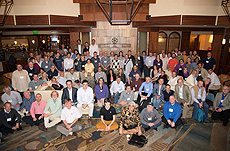LBNE gains new partners from Brazil, Italy and UK
 |
| Many new international partners officially joined LBNE during the collaboration meeting earlier this month. Photo courtesy of Norm Buchanan |
LBNE is making headway toward becoming a truly global experiment.
Last week 16 institutions from Brazil, Italy and the UK joined the LBNE collaboration, based at Fermilab, significantly contributing to an overall membership increase of over 30 percent compared to a year ago.
The swelling numbers strengthen the case to pursue an LBNE design that will maximize its scientific impact, helping us understand how neutrinos fit into our understanding of matter, energy, space and time.
In mid-2012 an external review panel recommended phasing LBNE to meet DOE budget constraints. In December the project received CD-1 approval on its phase 1 design, which excluded both the near detector and an underground location for the far detector.
"Although LBNE was reconfigured for CD-1, our goal is still to deliver a full-scope, fully capable LBNE to enable world-leading physics," Project Director Jim Strait told the LBNE collaboration earlier this month at its meeting in Fort Collins, Colo. "We have a well-developed design of such a facility, and we are working with new partners to move toward this goal."
Fortunately, the CD-1 approval explicitly allows for an increase in design scope if new partners are able to bring additional resources. Under this scenario, goals for a new, expanded LBNE phase 1 bring back these excluded design elements, which are crucial for executing a robust and far-reaching neutrino, nucleon decay and astroparticle physics program.
Over the last few months, neutrino physicists from institutions in several countries have expressed interest in joining LBNE. Discussions are under way to identify areas of mutual interest and understanding the potential scale of collaboration.
"These groups bring a wealth of physics and technology expertise to the collaboration," said Bob Wilson of Colorado State University, who, with fellow spokesperson Milind Diwan of Brookhaven National Laboratory and others, has been actively building these partnerships.
Physicist Ricardo Gomes of the Federal University of Goiás in Brazil, whose group is already a member of the MINOS+ and NOvA experiments, said that LBNE is a natural next step.
"LBNE is a great opportunity to work on an exciting experiment from the start, one that will help to answer important neutrino questions," Gomes said. "We hope to work on simulation of background events from cosmic-ray muons and would like to contribute to the photon detector instrumentation."
Fermilab Director Nigel Lockyer is pleased with LBNE's recent growth.
"It's incredibly encouraging that so many around the globe are signing on as official LBNE collaborators," Lockyer said. "To get as much science as we can out of it, LBNE must be a global project."
—Anne Heavey
|